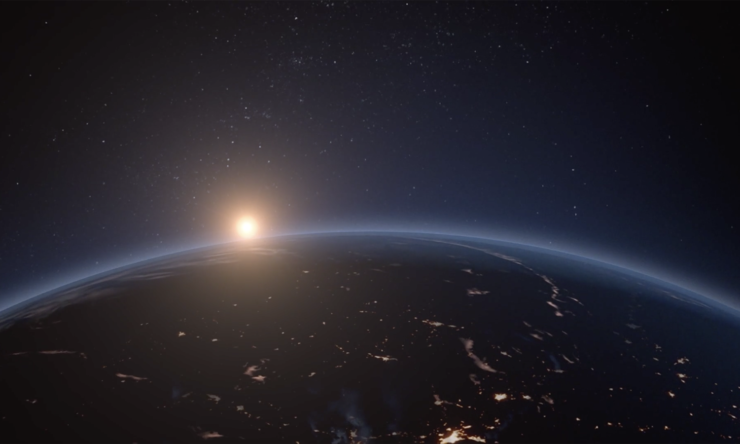The powers that be seem to be pushing us toward a day when the Earth has been radically pruned and reorganized to support humans and their domesticated species (animal and vegetable). Nothing else counts. Some would say that this would destroy the very ecology that supports us and our domesticates and would lead to mass extinctions and then an uninhabitable Earth. These malcontents assert that we have to care for our current home, because “there is no Planet B.”
Scientific exploration of exoplanets is in its earliest days. Perhaps there is a Planet B out there somewhere. That would surely solve all our problems…wouldn’t it? These five authors have their doubts.
Methuselah’s Children by Robert A. Heinlein (1958)
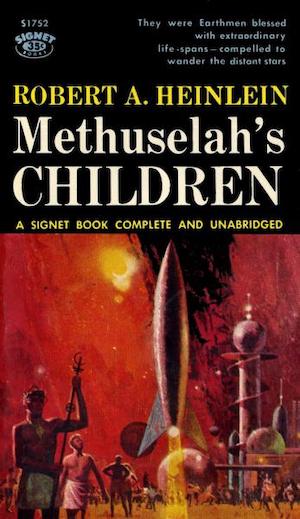
Confident that society had matured enough to accept the presence of a sub-population of age-resistant quasi-immortals, the Howard Families revealed their existence to their short-lived neighbors. Said neighbors wasted little time disappointing the Howards. Surely, there must be a secret to extended life beyond good genes! Surely, the Howard Families can share…and if they won’t, then they must be forced to share.
Realizing too late the extent of their error, the Howard Families, led by Lazarus Long, hijack a convenient sublight starship and flee a hostile Solar System. The good news? Either they are lucky or habitable worlds are common: their very first destination has a habitable world. The bad news? The planet is not just habitable but inhabited—by entities, some of whom are nigh godlike in their powers. Flight seems a logical response…but what waits on the next world is perhaps even more disquieting.
At this point in Heinlein’s career, aliens (even seemingly backward ones like Space Cadet’s Venusians) are always worthy of respect. In this case, the aliens are as gods. Contact with them is disquieting. (Later, Heinlein seems to have changed his mind about aliens [see Starship Troopers].)
“Vaster than Empires and More Slow” by Ursula K. Le Guin (1971, Collected in The Wind’s Twelve Quarters)
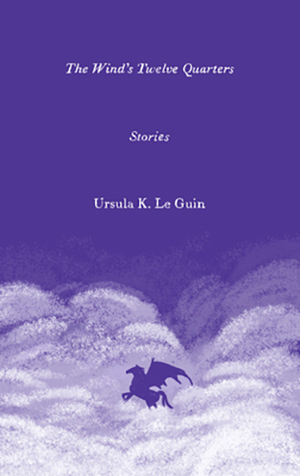
The League of All Worlds abounds with habitable, inhabited worlds, but all were seeded in ages past by the ancient Hain. Whether Earthlike worlds are as common outside the reach of the old Hain is unclear. Thus, the League dispatches a sublight ship to World 4470, well beyond the realm settled a million years ago.
World 4470 is habitable. Unlike the League worlds, it lacks native humanoids. World 4470 appears to lack animal life of any variety. It is a veritable living paradise, whose occupants are of a nature humans cannot easily recognize as possessing minds like theirs. It’s a Garden of Eden whose snake is the shipload of humans contaminating a world they do not understand.
It probably didn’t help the explorers manage this first contact that, until World 4470, the League of All Worlds only had to manage establishing relations between closely related human species. Dealing with entities outside their genus, let alone kingdom, is not in their skillset.
The Gates of Eden by Brian Stableford (1983)
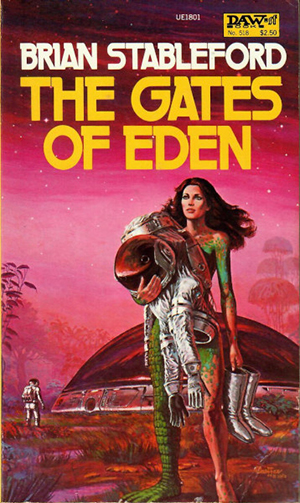
Hyperspace provided access to the universe with a very important catch. There is no known way for a ship to navigate within hyperspace without a hyperspace beacon at the destination. The primary method of planting beacons in extrasolar systems is sublight starship. Consequently, exploration of the galaxy has been much more glacial than one might expect, given FTL drives.
After centuries of travel, sublight probe Ariadne reports the third known Earthlike world, this one without an indigenous technological civilization. Previous experience suggests that Earthlike worlds produce Earthlike species. Previous experience is biased by the fact that the only two known Earthlike worlds have indigenous technological civilizations: evolution had to have proceeded down paths that produced technologically adept humanoid beings. There are other options available, life paths worlds like Earth and Calicos (the second world discovered) should fear.
For some reason, telescope technology always seems to lag in universes with superluminal flight. We’re already cataloging exoplanets but the civilizations in this book have to send physical probes to other systems. Presumably, there’s an inverse function between remote sensing and transportation technology. Build a fast enough starship and determining the nature of alien worlds might require licking them.
The Expert System’s Brother by Adrian Tchaikovsky (2018)
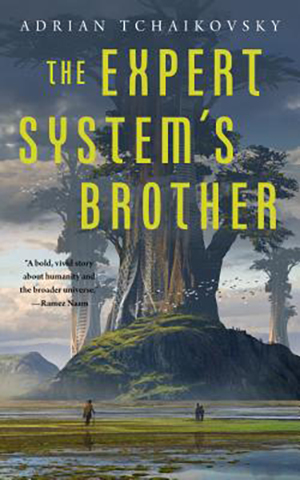
Although no person living in the era in which TESB is set remembers this, whoever settled the planet at the centre of the narrative discovered firsthand the difference between “life-bearing” and “habitable.” The world has its own history, as rich and diverse as Earth. Alas, it does not offer a niche in which humans can live. Unless they are extensively modified.
Thanks to aging Doctor Corto’s carelessness, young Handry is exposed to a substance intended to identify condemned criminals as the shunned. A full dose would have immediately transformed Handry into a doomed outcast. As it is, exile is only deferred. Handry is ultimately cast out. If he is to survive, he must rediscover some facts about his world.
Whoever settled this world seems to have gone well out of their way to find as cruel and inhumane a solution to their situation as possible.
Meru by S. B. Divya (2023)
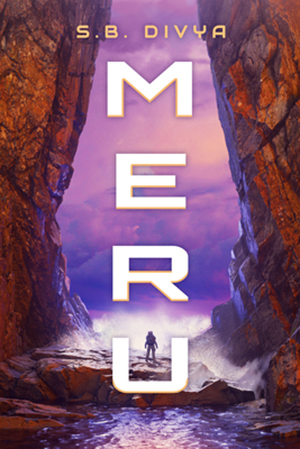
The human track record re: violence and environmental spoilation is dismal; hence the Constructed Democracy of Sol confines humans to Earth. This quarantine would be disappointing if there were other habitable worlds to which humans could travel and perhaps emigrate. But there aren’t. The galaxy abounds with exoplanets, none of them Earthlike. Their environments would kill a naked human.
This is not a problem for humanity’s children, the cyborg Alloys, who are able to adapt to almost any circumstances. No surprise that Alloys outnumber baseline humans. They exist in numbers that allow them to handily outvote humans, which in turn permits the Alloys to confine their older kinfolk to despoiled Earth.
The newly discovered exoplanet Meru is marginally habitable by humans. Should humans be allowed to settle there? Conservatives say no, but more liberal folk push for carefully managed settlement. The question is to be settled by a test. Jayanthi, adopted human child of two Alloys, is sent to Meru. If she can explore and settle without giving into the human predilection for ruining worlds, then perhaps humanity might be allowed to settle there.
Such a development would upend Alloy-human relations. It is not surprising, therefore, that behind the scenes, steps are taken to ensure failure.
In the Alloys’ defense, by the time they stepped in and took over, baseline humans had trashed not just Earth but also Mars, courtesy of an insufficiently well-thought-out terraforming project. That said, the extremes to which Alloys are willing to go to assure predetermined results suggests they are closer to baseline humans than they would like to believe.
***
There is lots of plot potential in Earthlike worlds that prove to be much less habitable than first believed (Brian Stableford in particular returned to that theme over and over). There are many I did not mention. Feel free to list your favourites in comments, which are, as ever, below.
In the words of fanfiction author Musty181, four-time Hugo finalist, prolific book reviewer, and perennial Darwin Award nominee James Davis Nicoll “looks like a default mii with glasses.” His work has appeared in Interzone, Publishers Weekly and Romantic Times as well as on his own websites, James Nicoll Reviews (where he is assisted by editor Karen Lofstrom and web person Adrienne L. Travis) and the 2021 and 2022 Aurora Award finalist Young People Read Old SFF (where he is assisted by web person Adrienne L. Travis). His Patreon can be found here.










